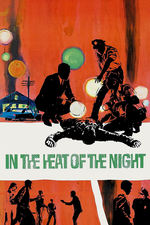In the Heat of the Night (1967)
February 5, 2015 8:58 PM - Subscribe
African American police detective Virgil Tibbs is passing through the racist, southern town of Sparta, MIssissippi when he is asked to investigate the murder of a prominent white businessman.
Slate, Revisiting In the Heat of the Night: To Jewison's credit, there are no scenes in which the story stops dead to make a point about racism. Instead, the themes assert themselves in every crosswise glance and smirk, and in the wary strength with which Tibbs holds himself rigid in the presence of white strangers. That said, some of Jewison's motifs resonated in 1967 in a way that is hard to imagine today. Watch how his camera follows Poitier's hands throughout the movie, lingering every time they touch white skin. As Tibbs works over the victim's corpse, palpating his palms and feet with clinical detachment, we can feel the sense of affront from the white onlookers around the makeshift morgue slab—and we can feel Tibbs feeling it. When Tibbs examines the fingers and forearms of a handcuffed murder suspect (a moment that, for 1967 audiences, might have evoked memories of Poitier chained to Tony Curtis in The Defiant Ones [previously]), we can intuit the white man's bred-in-the-bone humiliation giving way to self-interest as he realizes that Tibbs might help him.
Directors Guild of America, The Slap Heard Round the World: Jewison had promised a justifiably concerned Poitier that they wouldn’t actually shoot in the South. But to capture the slap scene, and the cotton plantation that surrounded it, Jewison persuaded Poitier to go to Dyersburg, Tenn., for three days. To be on the safe side, the star kept a gun under his pillow at the Holiday Inn. “Feelings were that high,” recalls Jewison. “This was not a period film. It was taking place in the present time.”
"In the Heat of the Night:" 25 Things You Didn't Know About the Sidney Poitier Classic.
Showtime to make new "In the Heat of the Night" series.
Trailer
"The slap" scene
"They call me MISTER TIBBS!" scene
Slate, Revisiting In the Heat of the Night: To Jewison's credit, there are no scenes in which the story stops dead to make a point about racism. Instead, the themes assert themselves in every crosswise glance and smirk, and in the wary strength with which Tibbs holds himself rigid in the presence of white strangers. That said, some of Jewison's motifs resonated in 1967 in a way that is hard to imagine today. Watch how his camera follows Poitier's hands throughout the movie, lingering every time they touch white skin. As Tibbs works over the victim's corpse, palpating his palms and feet with clinical detachment, we can feel the sense of affront from the white onlookers around the makeshift morgue slab—and we can feel Tibbs feeling it. When Tibbs examines the fingers and forearms of a handcuffed murder suspect (a moment that, for 1967 audiences, might have evoked memories of Poitier chained to Tony Curtis in The Defiant Ones [previously]), we can intuit the white man's bred-in-the-bone humiliation giving way to self-interest as he realizes that Tibbs might help him.
Directors Guild of America, The Slap Heard Round the World: Jewison had promised a justifiably concerned Poitier that they wouldn’t actually shoot in the South. But to capture the slap scene, and the cotton plantation that surrounded it, Jewison persuaded Poitier to go to Dyersburg, Tenn., for three days. To be on the safe side, the star kept a gun under his pillow at the Holiday Inn. “Feelings were that high,” recalls Jewison. “This was not a period film. It was taking place in the present time.”
"In the Heat of the Night:" 25 Things You Didn't Know About the Sidney Poitier Classic.
Showtime to make new "In the Heat of the Night" series.
Trailer
"The slap" scene
"They call me MISTER TIBBS!" scene
You are not logged in, either login or create an account to post comments

posted by maxsparber at 8:18 AM on February 6, 2015 [2 favorites]